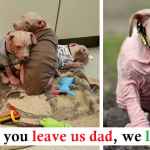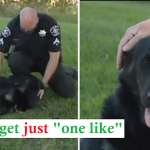This household had a big dog, and their narrative started in entrance of an house constructing with many tales. A German guard was attacked by a gaggle of vicious dogs whereas unable to defend itself. Nonetheless, this girl’s partner was unafraid to defend the guard dog and likewise began to drive away the imposing, barking mongrels after choosing up a board. The small girl embraced the massive pet dog and mentioned “Dolph!” when the shepherd was saved.
A household and loving house owners have been ultimately discovered for the shepherd dog that had been discovered wandering the road. The one that was defending this huge, unkempt, bushy particular person loved it loads. He instantly threw it in his automotive and drove it over to the vet’s workplace. Analyzing the dog revealed that it was unwell and likewise wanted to be fed correctly. They introduced the pet to their rural residence, the place Dolph ran in regards to the expansive grass with nice pleasure.
It now travels the nation together with his house owners as a full-fledged member of the family, and he particularly enjoys fishing and consuming scrumptious fish. It additionally has a ton of fur, so the house owners had to purchase two robotic vacuum cleaners directly to scrub the home of the shaggy’s fur.
Dolph turned out to be a real pal for the toddler. They interact in play collectively and share sleeping preparations. Even as soon as she reaches maturity, she plans to stay in Dolph’s family.
nteractions between dogs and children should be carefully managed to ensure the safety and well-being of both parties. Here are some of the best tips for facilitating a positive relationship between your dog and your child:
- Supervision: Always supervise interactions between your dog and your child, especially when they are young and may not understand how to properly interact with the dog. Even the most well-behaved dog can react unexpectedly to a child’s actions, so it’s crucial to be present to intervene if needed.
- Teach Respect: Teach your child to respect the dog’s space and boundaries. Show them how to approach the dog calmly and gently, avoiding sudden movements or loud noises that could startle or upset the dog. Encourage them to ask permission before petting or interacting with the dog.
- Educate Your Child: Educate your child about dog body language and signals that indicate stress or discomfort. Teach them to recognize signs of fear, aggression, or anxiety in the dog, such as growling, baring teeth, or backing away. Help them understand when it’s best to give the dog space and when it’s safe to approach.
- Positive Reinforcement: Encourage positive interactions between your child and the dog by rewarding both parties for calm, gentle behavior. Praise your child for being kind and respectful to the dog, and praise the dog for responding well to your child’s presence. Positive reinforcement helps build trust and strengthens the bond between your dog and your child.
- Set Boundaries: Establish clear boundaries for both your dog and your child. Teach your child which areas of the house are off-limits to the dog, such as the dog’s bed or food bowl. Similarly, establish rules for the dog, such as not jumping on furniture or begging for food from the child’s plate. Consistency is key in enforcing these boundaries.
- Teach Responsibility: Involve your child in the care and feeding of the dog to instill a sense of responsibility and empathy. Assign age-appropriate tasks, such as filling the dog’s water bowl, brushing their fur, or helping with obedience training. Teaching your child to care for the dog fosters a sense of connection and empathy towards animals.






